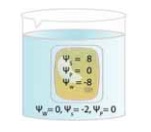Transport in Plants | Plant Physiology (Functional Organisation) | Botany - Answer the following questions | 11th Botany : Chapter 11 : Transport in Plants
Chapter: 11th Botany : Chapter 11 : Transport in Plants
Answer the following questions
Plant Physiology (Functional Organisation)
Transport in Plants
6. If the concentration of salt in the soil is too high and the plants may wilt even if the field is thoroughly irrigated. Explain
Answer:
High
salt concentration results in high be osmotic potential of the soil solution,
so the plant has to use more energy to absorb water. Under extreme salinity
conditions, plants may be unable to absorb water and will wilt even if the
surrounding soil is thoroughly irrigated. This is also referred to as the
osmotic or water deficit effect of salinity.
7. How phosphorylase enzyme open the stomata in starch sugar interconversion theory?
Answer:
1.
The discovery of enzyme phosphorylase in guard cells by Hanes (1940) greatly
supports the starch - sugar interconversion theory.
2. The enzyme phosphorylase hydrolyses starch into sugar and high PH followed and the opening of takes place during the night
Day
• Starch ---Phoshorylase
→ sugar
•
Photosynthesis occur
•
pH – increased
•
Movement of water from subsidiary cells to guard cells
•
Guard cells become turgid
•
Opening of stomata
Night
•
Sugar ---Phoshorylase → starch
•
No Photosynthesis
•
pH-lowered
•
Movement of water from guard cells
•
Guard cells become flaccid
•
Closure of stomata
8. List out the non-photosynthetic parts of a plant that need a supply of sucrose?
Answer: Roots-Stem of old plants-flowers & fruits.
9. What are the parameters which control water potential?
1.
Slatyer and Taylor (1960) introduced the concept of water potential.
Definition - water
potential is the potential energy of water in a system - compared to pure water
when temperature and pressure are kept constant.
2.
It is also a measure of how freely water molecules can move in a particular
environment or system. Water potential
is denoted by the Greek symbol ѱ
(psi) and measured in Pascal (Pa).
At standard temperature, the water potential of pure water is zero
3.
Addition of solute to pure water decreases
the kinetic energy thereby decreasing the water potential, from zero to
negative.
4.
So, Comparatively a solution always has low water potential than pure water. In
a group of cells with different water potential, a water potential gradient is
generated.
5.
Water will move from higher water potential to lower water potential
When
potential (ѱ) can be determined by.
Solute
concentration or Solute potential ( Ń°s)
Pressure
potential (Ń°P)
By
correlating two factors, water potential is written as,
(Ń°w = Ń°s) + Ń°P
a) Solute potential (Ń°s) or
Osmotic potential
1.
Denotes the effect of dissolved solute on water potential.
2.
In pure water, the addition of solute
reduces its free energy and lowers the water potential value from zero to
negative.
3.
Thus the value of solute potential is always negative. In a solution at
standard atmospheric pressure, water potential is always equal to solute
potential
(Ń°w
= Ń°s ) .
b) Pressure Potential (Ń°P)
1. Pressure potential is a
mechanical force working against the effect of solute potential.
2. Increased pressure potential will increase water potential and water enters cell and cells become turgid.
3.
This positive hydrostatic pressure within the cell is called Turgor. pressure likewise, withdrawal
of water from the cell decreases the water potential and the cell becomes
flaccid.
10. An artificial cell made of selectively permeable membrane immersed in a beaker (in the figure). Read the values and answer the following questions?

a. Draw an arrow to indicate the direction of water movement
b. Is the solution outside the cell isotonic, hypotonic or hypertonic?
c. Is the cell isotonic, hypotonic or hypertonic?
d. Will the cell become more flaccid, more turgid or stay in original size?
e. With reference to artificial cell state, the process is endosmosis or exosmosis? Give reasons
Answer:
a)

b)
The solution outside the cell is hypotonic,
c)
The cell is hypertonic
d)
The cell will become more turgid.
e)
Endomosis.
Reason : Endomosis is defined as the osmotic entry ofsolvent into a cell when it is placed in pure water/ Hypotonic solution. The solution in the beaker outside the cell is pure water. ( Ń° w = 0). and water enters into the artifical cell which is placed inside the beaker of pure water. (i.e) from hypotonic to hypertonic solution.
Related Topics